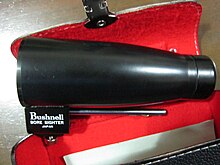Boresight (firearm)
This article needs additional citations for verification. (April 2012) |



Boresighting is a method of visually pre-aligning a
Optical boresighting
Optical boresighting, also referred to as "eyeball boresighting", as the name suggests, involves using the naked eye and the bore axis of a firearm to dial in the sights of a firearm. Based on the type of firearm the procedure for optical bore sighting will vary. For AR style rifles the upper receiver can be dropped from the lower receiver and the bolt carrier group (BCG) can be removed exposing a clear line of sight through the barrel. With the upper receiver fixed in place you can then co-witness through the barrel and the sights on the top of the rifle, while doing this you can visually align the bore axis with the sights on a desired target. For bolt actions rifles the process is the same aside from the ability to remove different receivers, but the bolt can still be removed to view through the barrel.
Once you are able to align the bore axis and the sights on the firearm you should then be able to at least get shots on or close to the target. With the rifle reassembled you should be able to put shots down range and make more fine-tuned adjustments.
A drawback of using the naked eye to boresight is that it can be difficult due to the
Laser boresighting
A more modern method of boresighting is to use a
As laser technology has become more affordable and portable, laser boresighters have become popular for sighting in
No matter which method of boresighting is used, the result is to align the sights to the spot where the barrel is pointing at a particular distance. Because of variations in the projectile trajectory and other factors, the boresighted rifle will always shoot below the boresighted spot and is only meant to approximate the actual points of impact, namely getting the shots "on paper" (landing in proximity to the point of aim). Live ammunition will need to be fired to further fine-tune the sighting process.
Accuracy is the measure of how well the sighted object is represented. It can be measured from a specific decision-making circumstance, like the orientation of notches of a gun barrel. Alternatively, the device could be designed to accommodate a range of circumstances and still be sufficiently accurate.
See also
References
- ^ Field & Stream. September 1970. p. 103.
- ^ Bonnier Corporation (June 1969). Popular Science. Bonnier Corporation. p. 160.
